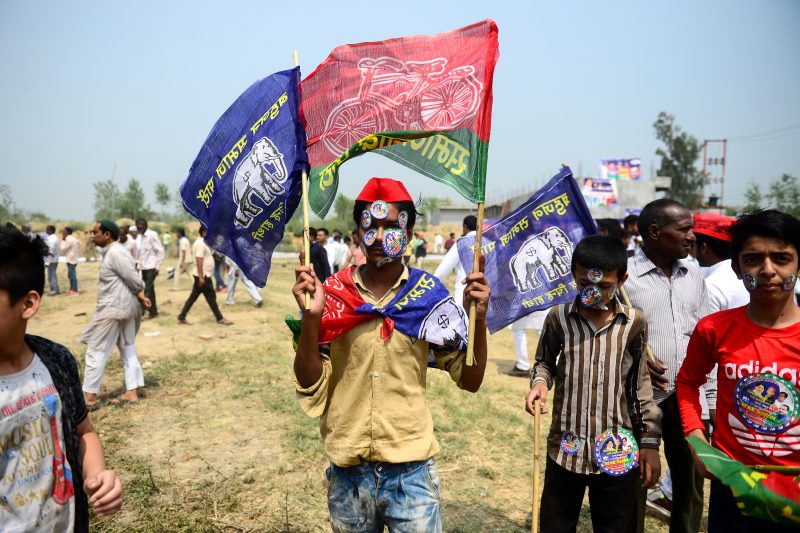India’s Modi eyes win in world’s biggest election
Some 900 million Indians can vote between April 11 and May 19 (SANJAY KANOJIA)
New Delhi (AFP) – India starts a mega-election on Thursday with Prime Minister Narendra Modi and his formidable campaign machine taking on not one but two Gandhis in the world’s biggest vote.
Tea-seller’s son Modi, boosted by February’s bust-up with Pakistan, remains popular, but he is vulnerable on the economy and his re-election depends on several key regions.
Some 900 million Indians can vote between April 11 and May 19 from the troubled snowy peaks of Kashmir to Rajasthan’s deserts and the tropical Andaman Islands.
The “festival of democracy”, as Modi calls it, needs seven phases, with thousands of parties and candidates running in 543 constituencies across the nation of 1.3 billion people.
Some of the 1.1 million electronic voting machines are transported through jungles and up mountains, including to one hamlet near the Chinese border with just one voter, and to a man living alone in a tiger reserve.
It is staggered partly because of the risk of violence, with over 100 politicians or party officials murdered in 2016 alone, and armed insurgencies raging in at least nine states.
– ‘National disaster’ –
Modi, 68, and his Hindu nationalist Bharatiya Janata Party (BJP) swept to power in 2014, the first party to win an absolute majority since Rajiv Gandhi in 1984.
Some of his promises have fallen short, particularly in rural areas where drought, low prices and loan sharks have driven thousands of farmers to kill themselves in recent years.
The economic policy most voters remember, the withdrawal of high-value banknotes worth 86 percent of the cash in circulation overnight in 2016 to try and bring the shadow economy into the light, caused mayhem.
He has however made it easier for foreign firms to do business in India, and carried out the biggest tax reform since independence, although this too had big teething problems.
But economic growth has been too slow to give jobs to the million Indians entering the labour market each month, and unemployment is reportedly at its highest since the 1970s.
Rahul Gandhi, 48, hoping to become the latest prime minister from his dynasty — and aided by sister Priyanka — has accused Modi of causing a “national disaster”.
“We want Modi to win again but his government should do something for our people,” said Hazi Qasam Koradia, 60, a spice trader in Mumbai.
– Holy cow –
The BJP has its radical Hindu roots and critics accuse Modi of propagating “Hindutva”, the hegemony of Hindus, to the exclusion of officially secular India’s sizeable minorities.
The BJP’s patronage of the cow — sacred to Hindus — has emboldened vigilantes to attack Muslims and low-caste Dalits for eating beef, slaughtering and trading in cattle, critics say. Muslim-sounding cities have been renamed, and school textbooks re-written.
Gandhi’s Congress party has profited from voter dissatisfaction, winning in December three key state elections, chipping into Modi’s core support base in the Hindi “Cow Belt” regions.
However, Modi’s popularity rose in February with India and Pakistan’s worst confrontation in years over Kashmir when the nuclear-armed arch rivals conducted tit-for-tat airstrikes.
He now calls himself India’s “chowkidar” (“watchman”), even changing his handle on Twitter, where he has 46.8 million followers, to “Chowkidar Narendra Modi”.
Anyone even questioning India’s actions against Pakistan is given short shrift, including on social media, a major battleground in a country where WhatsApp has its biggest market.
“Any critic of the government finds themselves under attack in one way or another,” Gilles Verniers, political science professor at Ashoka University, told AFP.
– ‘Safe hands’ –
Polls, although unreliable, suggest that the strategy has worked.
“The biggest issue is that our country should be in safe and secure hands like Modi’s,” said Balwant Singh, a fruit seller in the northern state of Haryana.
However, the BJP’s performance in several key states will determine whether it can retain power, and whether the silver-haired, silver-bearded Modi will remain prime minister.
In 2014, the BJP won big in Uttar Pradesh, India’s most populous state, but a new tie-up there between Mayawati, champion of the Dalits, and another regional party, means a repeat is unlikely.
To make up for this, the BJP is making a big push in north-eastern India and in West Bengal, where the popular and feisty Modi critic Mamata Banerjee rules the roost.
If Modi falls short of a majority and is forced into an alliance, or if other parties team up against the BJP, then this could even spell curtains for the prime minister.
“It’s difficult to predict,” said Parsa Venkateshwar Rao, a veteran journalist and political commentator.
“It reminds me of 2004 when (premier Atal Bihari) Vajpayee and the BJP lost when everyone expected them to win.”
Disclaimer: Validity of the above story is for 7 Days from original date of publishing. Source: AFP.


